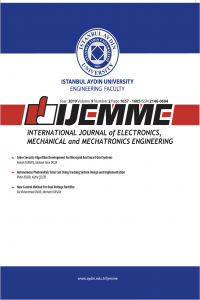A Prediction Model For Performance Analysis in Wireless Mesh Networks
A Prediction Model For Performance Analysis in Wireless Mesh Networks
Mesh networks, source management, prediction model generalized regression neural networks, performance analysis,
___
- Rappaport T.S., Wireless communications: principles and practice (2nd edition). Upper Saddle River, NJ: Prentice Hall PTR. ISBN 0-13-042232-0, 2002.
- Dai L., Yang W., Gao S., Xia Y., Zhu M., and Ji Z., “EMD-based multi-model prediction for network traffic in software-defined networks,” in IEEE 11th International Conference on Mobile Ad Hoc and Sensor Systems (MASS), Philadelphia, PA, pp. 539-544, 2014.
- Das S.M., Pucha H., Koutsonikolas D., Hu C., and Peroulis D., “Dmesh: Incorporating practical directional, antennas in multi-channel wireless mesh networks,” in IEEE J. Sel. Areas Commun., vol. 24, no. 11, pp. 2028-2039, 2006.
- Ahmed N.M., and Chen L., “An efficient algorithm for link prediction in temporal uncertain social networks,” Information Sciences, vol. 331, pp. 120-136, 2016.
- Wu M., Tan L., and Xiong N., “Data prediction, compression, and recovery in clustered wireless sensor networks for environmental monitoring applications,” Information Sciences, vol. 329, pp. 800-818, 2016.
- Priya S.B.M., “Adaptive control of routing protocol in mobile adhoc network using regression model,” in International Conference on Emerging Trends in Science, Engineering and Technology (INCOSET), Tiruchirappalli, Tamilnadu, India, vol. 13-14, pp. 509-514, 2012.
- Gu C., Zhang S., Xue X., and Huang H., “Online wireless mesh network traffic classification using machine learning,” Journal of Computational Information Systems, vol. 7, no. 5, pp. 1524-1532, 2011.
- Alzubir A., Bakar K.A., Yousif A., and Abuobieda A., “State of the art, channel assignment multi-radio multi-channel in wireless mesh network,” International Journal of Computer Applications, vol. 37, no. 4, pp. 14-20, 2012.
- Riggio R., Pellegrini F.D., Miorandi D., and Chlamtac I., “A knowledge plane for wireless mesh networks,” Ad Hoc & Sensor Wireless Networks, vol. 5, pp. 293-311, 2007.
- Yarali A., Ahsant B.., and Rahman S., “Wireless mesh networking: a key solution for emergency&rural applications,” in IEEE Second International Conference on Advances in Mesh Networks, pp. 143-149, 2009.
- Draves R., Padhye J., and Zill B., “Comparison of routing metrics for static multi-hop wireless networks,” in Conference on Applications, technologies, architectures, and protocols for computer communications (SIGCOMM), pp. 133-144, 2004.
- Raniwala A., and Chiueh T., “Architecture and algorithms for an IEEE 802.11-based multi-channel wireless mesh network,” in 24th Annual Joint Conference of the IEEE Computer and Communications Societies, New York, pp. 2223-2234, 2005.
- Received from: https://tools.ietf.org/html/rfc3626
- Zurada J.M., Introduction to artificial neural systems. West Publishing Co., St. Paul, MN, USA, 1992.
- Specht D.F., “A general regression neural network,” IEEE Transactions on Neural Networks, vol. 2, no. 6, pp. 568-576, 1991.
- Wasserman P.D., Advanced methods in neural computing. New York, Van Nostrand Reinhold, pp. 155-61, 1993.
- MATLAB Release 2015a, The MathWorks, Inc., Natick, Massachusetts, United States.
- ISSN: 2146-0604
- Başlangıç: 2011
- Yayıncı: İstanbul Aydın Üniversitesi
Circularly Polarized Slot Antenna for wireless Applications
Yasin AMANI, Yashar Zehforoosh
Control of Fuel Cell Power System
Ayşe KOCALMIŞ BİLHAN, Caisheng WANG
An Optimization Model And Genetic Algorithm Solution For Software Projects
Yücel DİL, Mustafa Cem KASAPBAŞI
A Prediction Model For Performance Analysis in Wireless Mesh Networks
